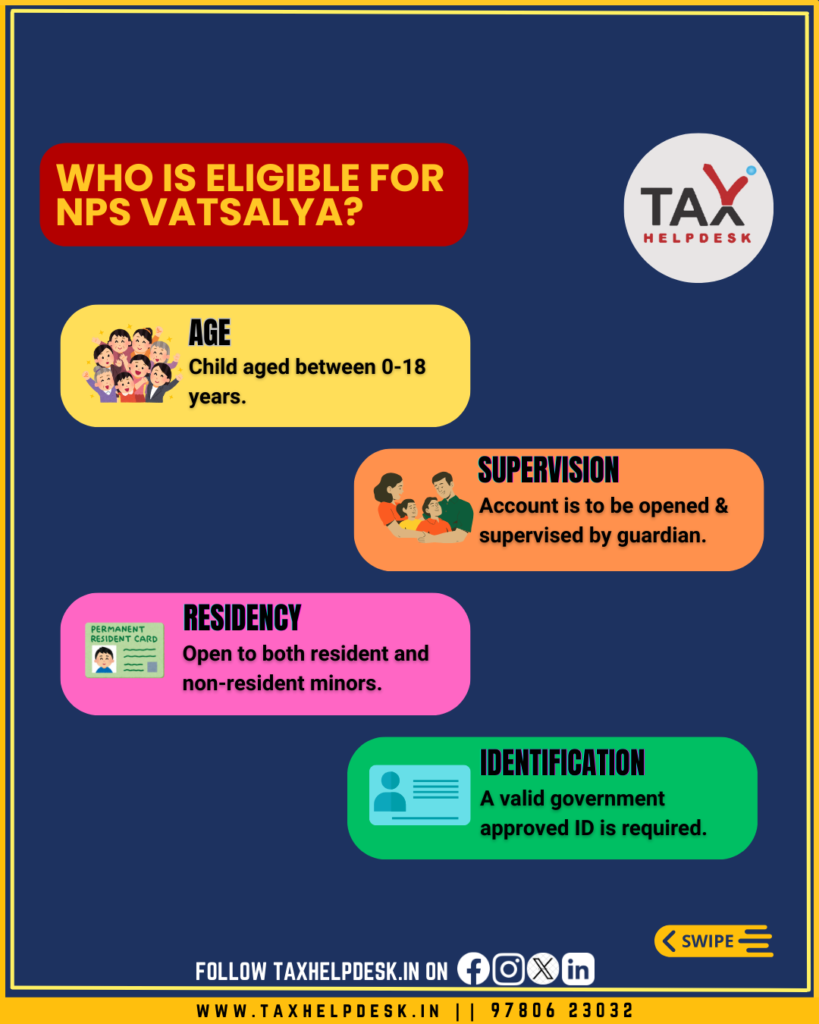NPS Vatsalya (National Pension Scheme Vatsalya) was introduced by the Finance Minister Smt. Nirmala Sitharaman during the Union Budget, 2024. Having said this, the NPS Vatsalya Scheme aims at future planning of the minors. Not only this, this scheme also aims at promoting the habit of savings from an early age.
How does the NPS Vatsalya Scheme Work?
Under the NPS Vatsalya Scheme, the guardians can invest on behalf of the child for the betterment of his/her future. Further, the working of this scheme is such that the guardians can contribute the amount in the child’s name till he/she attains the age of 18 years. Once the child attains 18 years, the accounts transition in the child’s name. Accordingly, the child can convert the account into a regular NPS account or another non-NPS scheme.
Eligibility to open the NPS Vatsalya Account
Guardian of the minor can open the NPS Vatsalya Account for their child/children. In other words, minor children up to the age of 18 years are eligible to open this account. Though the account is in the name of the minor, the guardian of the child manages it. This scheme, by doing so, ensures that the child remains the sole beneficiary throughout the entire process. Further, the minor and guardian of the child can be resident or non-resident of India.
Also Read: Sukanya Samridhi Yojana: Important Pointers You Need To Know

Key Features of the NPS Vatsalya Scheme
The key features of the NPS Vatsalya are:
– Guardian/Parents can open the account as well as contribute in the name of minors.
– Minors are the sole beneficiaries
– Account transitions in the name of the child on attaining adulthood
– Easy conversion into regular NPS account or non-NPS account on completion of 28 years
– There is a choice of fund manager and asset allocation
– There is no upper limit on contribution in NPS Vatsalya
– However, the only disadvantage is that there are no tax benefits applicable on NPS Vatsalya contribution.
Also Read: Know The Tax Saving Options Available Only To Women
Who can invest in NPS Vatsalya?
Under the NPS Vatsalya, the guardian of the minor can invest until the child turns 18 years of age. This is to say that the account is in the name of the child, but the guardian of the child makes the investments.
Also Read: All About The National Pension Scheme
Where can you open the NPS Vatsalya Account?
The parents or the guardian can open the NPS Vatsalya Account via banks, post offices, pension fund offices or the e-NPS Portal.
Minimum and Maximum Amount Required to Invest in Scheme
To open NPS Vatsalya Account, the minimum amount of Rs. 1000 is required to be invested. However, there is no maximum limit, and the account holder can invest as much amount as they want to. In addition to this, the account holder needs to invest a minimum of Rs. 1,000 every year after opening the account.
Investment Options Unnder NPS Vatsalya
The investment options under the NPS Vatsalya are as follows:
Default Choice: Moderate Life Cycle Fund which allocates 50% of the fund investments in equity.
Auto Choice: In the auto choice option, the guardian can select the three lifecycle funds based on their risk tolerance level. These three lifecycle funds are: Aggressive LC-75, Moderate LC-50 and Conservative LC-25.
The Aggressive LC-75, as the name suggests, allocates up to 75% of the investments in the equity and is suitable for those who have a higher risk appetite.
Moderate LC-50 has a balancing approach and allocates 50% of the investments in equity.
Lastly, Conservative LC-25 believes in minimizing risks and thereby allocates only 25% in equity.
Also Read: Taxability of Pension: All You Need To Know
Documents Required:
To open a NPS Vatsalya account, following documents are necessary:
Proof of Date of Birth of the Minor: Birth Certificate, School Leaving Certificate, Matriculation Certificate, PAN or Passport.
KYC Documents of the Guardian: KYC documents of the guardian include documents of proof of identity and address like the Aadhaar, Driving License, Passport, Voter ID Card, NREGA Job Card, or National Population Register documents.
Permanent Account Number (PAN) of the Guardian
NRE/NRO Bank Account (solo or joint): In case, the minor or the guardian are Non-Resident Indian (NRI) or Overseas Citizens of India (OCI).
Withdrawal Rules
| S.No. | Scenario | Description |
|---|---|---|
| 1. | Partial Withdrawal |
Allowed after 5 years for: – Education – Medical Treatment – Marriage of the minor (where custom allows) |
| 2. | Maturity |
At the age of 18 years – 60% corpus withdrawal is tax-free – 40% is to be used for buying an annuity |
| 3. | Pre-mature exit |
Permitted in case of unforeseen circumstances – 80% of the corpus is to be used in buying an annuity |
| 4. | Death of the subscriber |
Entire corpus – Entire corpus can be claimed by the legal heir of the nominee |
Do you have any suggestions/feedback? Then, please leave the comment below. For more updates on Taxation, Financial and Legal matters, join our group on WhatsApp or follow us on Facebook, Instagram as well as Linkedin!


